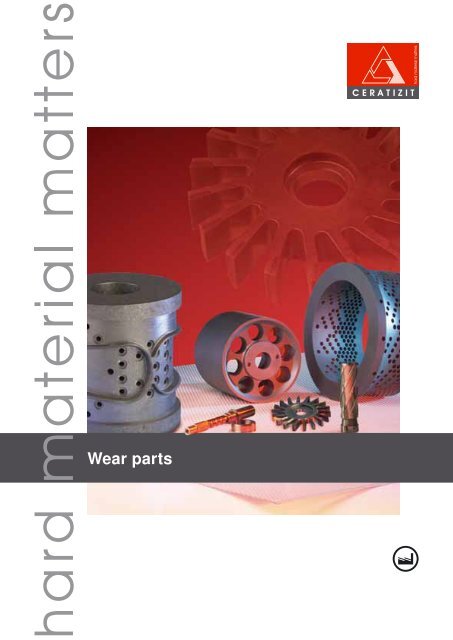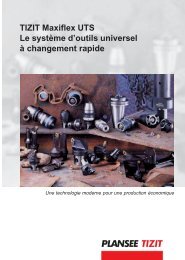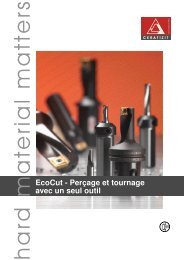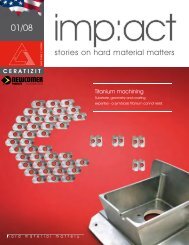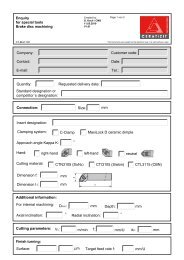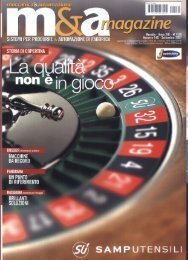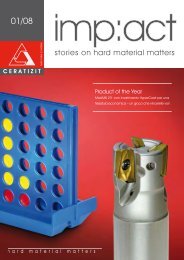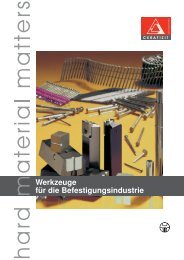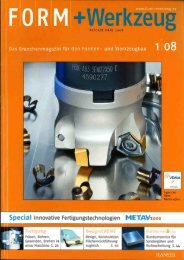Wear parts
Wear parts
Wear parts
You also want an ePaper? Increase the reach of your titles
YUMPU automatically turns print PDFs into web optimized ePapers that Google loves.
<strong>Wear</strong> <strong>parts</strong>
2<br />
CERATIZIT – the parent companies<br />
Headquarters and parent company in<br />
MAMER / Luxembourg<br />
Hard material matters – it is the<br />
core of our business. Through<br />
in-depth knowledge and highly<br />
flexible production facilities we<br />
strive to provide our business<br />
partners with direct competitive<br />
advantages in the field of hard<br />
materials for tooling solutions<br />
and wear <strong>parts</strong>. Our dedication<br />
to hard material matters creates<br />
intelligent solutions for tomorrow<br />
and time to come.<br />
North America<br />
• USA<br />
South America<br />
• Brasil<br />
Direct sales and distribution partners<br />
Production plants in the three<br />
main economic areas and a<br />
worldwide sales network of<br />
subsidiaries and distribution<br />
partners ensure a quick response<br />
to customer needs. In-house<br />
training courses and seminars<br />
guarantee that both business<br />
partners and employees share<br />
the latest information on our product<br />
range.<br />
Europe<br />
• Austria<br />
• Bulgaria<br />
• Czech Republic<br />
• France<br />
• Germany<br />
• Hungary<br />
• Italy<br />
• Luxembourg<br />
• Netherlands<br />
• Poland<br />
• Switzerland<br />
• Spain<br />
• United Kingdom<br />
Parent company in REUTTE / Austria<br />
We promote intensive dialogue<br />
with our customers and strive for<br />
long-term business relations on<br />
a partnership basis.<br />
The CERATIZIT corporate value<br />
‘The focus and point of view of<br />
our business partners matters’<br />
is a guiding principle for all<br />
CERATIZIT employees worldwide.<br />
Asia<br />
• China<br />
• India<br />
• Japan
CERATIZIT – other production sites for wear <strong>parts</strong><br />
CERATIZIT Hitzacker, Germany<br />
Production site for:<br />
• blanks for metal forming<br />
CERATIZIT Horb, Germany<br />
Production site for:<br />
• general wear <strong>parts</strong> and preforms<br />
CERATIZIT Schweiz AG<br />
Production site for:<br />
• blanks and finished <strong>parts</strong> for<br />
various segments<br />
CERATIZIT Columbia South Carolina, USA<br />
Production site for:<br />
• balls and products for the wood industry<br />
CERATIZIT Warren Michigan,<br />
USA<br />
Production site for:<br />
• carbide formed <strong>parts</strong> for<br />
the American market<br />
3
4<br />
Blanks for<br />
metal forming<br />
Sealing rings<br />
Automotive industry<br />
Food industry<br />
Wire industry<br />
<strong>Wear</strong> <strong>parts</strong> for<br />
industrial applications<br />
Oil industry<br />
Brick industry<br />
Chemical industry<br />
Electronics/electrical engineering<br />
Nozzles
<strong>Wear</strong> <strong>parts</strong> for<br />
industrial applications<br />
Glass industry<br />
Coating technology<br />
Rotary cutters<br />
CERATIZIT is the world market<br />
leader in selected industry sectors<br />
for unique and consistently<br />
innovative hard material products.<br />
General<br />
wear <strong>parts</strong><br />
Lock industry<br />
Crushing/recycling<br />
Stone working<br />
High-pressure tools<br />
Parts for high-speed<br />
machines<br />
5
6<br />
Hard materials for wear <strong>parts</strong><br />
Hard materials in general and hard metals in particular offer a series of interesting properties for all<br />
applications where maximum wear resistance is required. In practical applications, wear <strong>parts</strong> are<br />
usually influenced by various interdependent factors: high pressure, high temperature, use of abrasive<br />
or aggressive media, machining of hard materials. These are only some examples of criteria causing<br />
wear, which hard materials or hard metals have to be resistant to. The powder-metallurgical production<br />
of CERATIZIT wear <strong>parts</strong> enables tailor-made wear resistance of the material.<br />
This is what makes CERATIZIT hard materials and hard metals indispensable when it comes to<br />
decisively increasing the service life of highly stressed components. Ever more powerful machines,<br />
facilities and machining methods create daily new challenges for the CERATIZIT development<br />
engineers. Our development projects are characterised by close cooperation with customers as well as<br />
a joint search for solutions to application problems.<br />
Causes of wear<br />
Abrasion<br />
Cutting with water-jet and abrasive<br />
additives at a pressure of<br />
4000 bar (approx. 500g sand/min.)<br />
Temperature<br />
Cutting of molten glass.<br />
Temperature 1,250°C<br />
Pressure/mechanical<br />
stress<br />
Tool for the synthesis<br />
of CBN and PCD<br />
pressure during operation:<br />
72,000 bar
Competence and know-how<br />
At CERATIZIT we consider the carbide<br />
business to be a matter of confidence.<br />
Decades of experience in carbide<br />
development and production enable us<br />
to offer you this confidence. Our quality<br />
management systems meet the highest<br />
standards. This is documented by the<br />
ISO9001:2000 quality certificate.<br />
Our facilities and production methods<br />
represent state-of-the-art technology<br />
because only modern and innovative<br />
production procedures offer the possibility<br />
to fulfil complex tasks economically.<br />
Engineering know-how and competent<br />
on site application advice, as well<br />
as intensive cooperation with our<br />
customers make the difference.<br />
Make use of our professional service.<br />
Our dedication to hard material matters<br />
creates intelligent solutions for<br />
tomorrow and time to come.<br />
7
8<br />
Tungsten oxide<br />
Reduction<br />
Tungsten<br />
Carburising<br />
Tungsten<br />
carbide<br />
Carbide production / blanks<br />
Carbide is a composite material consisting of particles mainly with tungsten carbide as hard material<br />
and a metallic binder. For this reason, with carbide it is possible to achieve hardness and toughness<br />
combinations which cannot be obtained with other materials. The graphic illustration below shows the<br />
basic steps for producing carbide blanks in the metal forming sector.<br />
Powder preparation<br />
Due to its high melting point tungsten carbide (WC) can only be produced through sintering when needed<br />
for technically sophisticated applications. For this purpose, the powder consisting of the tungsten carbide,<br />
the cobalt binder (Co) and sometimes additional alloys, is mixed, milled and spray-dried.<br />
This process results in a spray-dried granulate which can easily be used for production, since its chemical<br />
and physical properties have already been adapted to the final carbide specification (e.g. WC grain<br />
size).<br />
Co (NI,Fe)<br />
Mixing<br />
Milling<br />
TiC, TaC, NbC<br />
Cr3C2 , VC, MoC<br />
Granulation<br />
Carbide powder<br />
granulate
Manufacture and machining of blanks<br />
Carbide production<br />
By applying pressure the carbide powder is converted into a blank. The material will receive its near net<br />
shape through the application of traditional machining methods (sawing, drilling, milling, turning), so that<br />
extended machining of the sintered carbide blank is no longer necessary. The density of the blank is<br />
approx. 50% of the sintered carbide‘s density which leads to an approx. 20% shrinkage in length.<br />
Sintering<br />
Die<br />
pressing<br />
Sintering<br />
Blanks<br />
Isostatic<br />
pressing (cold)<br />
Optional:<br />
machining of blanks<br />
The sintering process converts the blank into a homogeneous piece of carbide with a high degree of<br />
hardness. When sintering hard metal (usually at a temperature of approx. 1400°C), this process is called<br />
liquid phase sintering. In this case, the binder (e.g. cobalt) melts and wets the WC hard material particles.<br />
After sintering, the density of the carbide is almost, or even precisely, the same as the theoretical density.<br />
Any residual porosity which occurs after the sintering procedure may be removed through an ensuing<br />
HIP process.<br />
Further processing<br />
9
10<br />
Grinding<br />
Carbide manufacturing / finishing<br />
CNC external and<br />
internal cylindrical<br />
grinding<br />
CNC surface and<br />
profile grinding<br />
Coatings / surface treatment<br />
Precision centreless grinding<br />
<strong>Wear</strong> <strong>parts</strong> with<br />
PVD or CVD coatings<br />
Face and parallel<br />
lapping<br />
CNC 5-axesgrinding<br />
Our machines and plants meet highest demands with regard to standards and functionality,<br />
precision and reliability.<br />
Our coating competence covers classic hard material coatings and functional tailor-made coatings<br />
for specific customer applications. For the production of coatings we apply CVD, PVD and galvanic<br />
processes. Special surface treatments are mainly applied to improve brazing properties.<br />
Parts with cobalt coating
Composite <strong>parts</strong><br />
For several applications it does not make sense to manufacture the entire component in hard metal.<br />
The use of hard metal is limited to the area in which wear occurs. Materials with suitable wearresistance<br />
are used for the carrier tool; they are easier to machine than carbide. For the combination of<br />
carbide with other materials, numerous tried and tested technologies are applied.<br />
Examples: brazing, gluing, clamping, connections with screws and shrinking.<br />
Erosion<br />
Control<br />
Chamfering insert<br />
brazed on steel part<br />
Cavity sinking of a<br />
coining die<br />
3D measurement of an<br />
extrusion pressing die<br />
Carbide ring glued on<br />
steel core<br />
Carbide treatment by means of spark erosion meets the highest technological standards. Wire erosion<br />
and cavity sinking by EDM additionally guarantee high precision. Long-standing experience combined<br />
with carbide grades that are specially adapted for erosion guarantee optimum machining results.<br />
Wire erosion of a<br />
formed part<br />
The control of finished components is part of our certified quality management system. This control is<br />
carried out by qualified staff, mainly on computer-controlled measuring machines. Control records are<br />
archived for 10 years. Upon request the customer can view the quality management records which are<br />
relevant for him.<br />
11
12<br />
<strong>Wear</strong> resistance<br />
Cermet<br />
Natural diamond<br />
Hard materials / carbide<br />
PCD<br />
Diamond coated<br />
CBN<br />
Ceramic (O)<br />
Ceramic (N)<br />
What is carbide?<br />
Cemented carbide<br />
HSS<br />
Toughness<br />
Carbide is a brittle, hard material<br />
with mechanical properties that<br />
can be adjusted within a very wide<br />
range, given its composition and<br />
microstructure. The hardness and<br />
toughness range of the CERATIZIT<br />
grades includes everything from<br />
wear resistant tool steel to super-hard<br />
ceramic materials.<br />
Carbide is a powder metallurgically produced composite material consisting of a hard material<br />
(e.g. tungsten carbide, WC) and a metallic binder (e.g. cobalt, Co)<br />
The hard material provides the necessary<br />
→ hardness<br />
→ wear resistance<br />
The metallic binder provides<br />
→ toughness<br />
Carbide properties depending on the Co contents<br />
and WC grain size<br />
Cobalt content ↑↑<br />
Grain size ↓↓<br />
T.R.S.<br />
High hardness<br />
(= wear resistance)<br />
WC<br />
Co<br />
WC<br />
Micrograph of WC-Co carbide<br />
Cobalt content ↓↓<br />
Grain size ↓↓<br />
Fracture<br />
toughness<br />
Cobalt content ↑↑<br />
Grain size ↑↑
The basis for optimum quality<br />
The graphic illustrations below show that the mechanical properties of the carbide mainly depend on the binder<br />
content (Co) and the TC grain size. Hardness, i.e. wear resistance, increases inversely/reciprocally proportional<br />
to the fracture toughness. This means that the harder the material the more it reacts to notch tensions and impact<br />
stress (the ‘impact resistance’ parameter, which cannot be precisely defined, correlates to a high degree with the<br />
fracture toughness of the material).<br />
On the other hand, the transverse rupture strength does not directly depend on the hardness but rather on the TC<br />
grain size and the cobalt content. The adhesive wear (tendency to stick), however, decreases with the grain size and<br />
the cobalt content of the carbide used. The list of the mentioned interdependencies, which could be extended at will<br />
for other wear and failure mechanisms, show that it is only possible to choose the correct carbide grade following a<br />
systematic procedure and/or based on experience with similar forming processes.<br />
Submicron grain<br />
Fine / medium grain<br />
Coarse grain<br />
Hardness [HV30]<br />
Transverse rupture strength [MPa]<br />
Toughness K IC-value [MPa*m 1/2 ]<br />
Submicron grain<br />
Fine / medium grain<br />
Coarse grain<br />
Submicron grain<br />
Fine / medium grain<br />
Coarse grain<br />
Submicron grain<br />
Fine / medium grain<br />
Coarse grain<br />
13
14<br />
CT<br />
grade<br />
code<br />
Grades ISO K Application<br />
range<br />
WC/Co grain size coarse/medium<br />
Grade characteristics<br />
Binder Hardness T.R.S. Grain<br />
size<br />
[%] HV10 HV30 HRA [MPa] [P.S.I.]<br />
CTM12 B10T K20 G10 6 1520 1500 91,1 2200 319.000<br />
CTM14 GC12 K25 G10 7 1550 1530 91,4 2600 377.000<br />
CTM17 GC15 K30-K40 G15 8,5 1420 1400 90,4 2800 406.000<br />
CTC12 GC17 K30 G10-G20 6 1350 1340 89,9 2800 406.000<br />
CTC20 B30T/GC32 K40 G20-G30 10 1170 1160 88,2 3000 435.000<br />
CTC25 B40T/CE65 >K40 G20-G30 12,5 1080 1070 87,2 3100 450.000<br />
CTC30 B50T/GC40 - G30-G40 15 1020 1010 86,5 3150 457.000<br />
CTC35 GC50 - G40-G50 17,5 950 940 85,6 3200 464.000<br />
CTC40 B60T/GC60 - G40-G50 20 900 890 84,9 3200 464.000<br />
CTC50 B70T/GC65 - >G50 25 810 800 83,5 3200 464.000<br />
CTC60 GC70 - >G50 30 730 720 82,2 3200 464.000<br />
WC/Co grain size fine<br />
CTF08 GC01 K05-K10 G01 4 1850 1820 93,2 2100 305.000<br />
CTF11 GC05/H10T K10 G05 5,5 1760 1730 92,7 2300 334.000<br />
CTF12 GC10/H20T/AG06 K20 G10 6 1630 1610 91,9 2300 334.000<br />
CTF18 H30T/AG09 K30 G15 9 1490 1470 91,1 2800 406.000<br />
CTF24 GC20/H40T/AG12 K40 G20 12 1350 1340 89,8 3000 435.000<br />
CTF30 GC30/H50T >K40 G30 15 1240 1230 88,8 3100 450.000<br />
CTF40 GC37/H60T - G40 20 1050 1040 86,7 3400 493.000<br />
CTF50 GC55/H70T - G50 25 950 940 85,4 3400 493.000<br />
CTF54 GC62 - >G50 27 920 910 85,0 3200 464.000<br />
WC/Co grain size submicron<br />
CTS06 MG06/TSM01 K01 - 3,3 2020 1980 93,9 3300 479.000<br />
CTS10 TSM05 K05 - 4,8 1980 1940 93,8 3300 479.000<br />
CTS12 MG12/TSM10 K05-K10 - 6 1850 1820 93,3 3500 508.000<br />
CTS15 MG15/TSM20 K10-K30 - 7,5 1740 1710 92,6 3600 522.000<br />
CTS20 MG18/TSM33 K20-K40 - 10 1650 1630 92,1 3700 537.000<br />
CTS24 MG24/TSM40 K40 - 12 1490 1470 90,9 4000 580.000<br />
CTS30 MG30 >K40 - 15 1330 1320 89,7 3800 551.000<br />
WC/Co grain size ultrafine<br />
CTU05 SMG02
CT<br />
grade<br />
code<br />
Grade characteristics<br />
CTU05R CTU05R 2,5 (NiCr) 2350 2250 95,0 2000 290.000<br />
CTU06M KCR05 - - 2,8 (CoNiCr) 2150 2110 94,5 2500 363.000<br />
CTS06M KCR06 - - 3 (CoNiCr) 1950 1910 93,6 2300 334.000<br />
CTU12R CTU12R - - 6 (NiCr) 1750 1720 92,6 2600 377.000<br />
CTU17R KR15 - - 8,5 (NiCr) 1760 1730 92,7 2500 363.000<br />
CTS17R KR16/V714 - - 8,5 (NiCr) 1600 1580 91,7 2800 406.000<br />
CTF16R KR17/TNI25 - - 8 (NiCr) 1480 1460 90,8 2900 421.000<br />
CTM16N K16 - - 8 (Ni) 1300 1290 89,4 2400 348.000<br />
CTC20M CTC20M - - 10 (CoNiCr) 1100 1090 87,3 2600 377.000<br />
CTC40M CTC40M - - 20 (CoNiCr) 850 840 84,0 2800 406.000<br />
CTC60M CTC60M - - 30 (CoNiCr) 650 640 80,9 2700 392.000<br />
When referring to carbide, ‘corrosion’ means the detachment of the binder caused by corrosive<br />
materials. This can cause early breakage (notching!) or notably increased wear. In this context<br />
carbides containing Co/Ni or Ni or a chromium-doped binder represent an advantage.<br />
The ferromagnetic properties of cobalt and nickel make it possible to magnetise carbides which have<br />
a suitable binder. Upon request some of the nickel-bound carbide grades can also be delivered as non<br />
magnetic grades.<br />
CT<br />
grade<br />
code<br />
Grades Density Binder Hardness T.R.S. Grain<br />
size<br />
[g/cm 3 ] [%] HV10 HV30 HRA [MPa] [P.S.I.]<br />
Cermets (TiC basis carbides)<br />
CTF28T TCN541 6,4 14 (CoNi) 1550 1530 91,4 2400 348.000<br />
CTF36T TWF18 5,9 18 (Ni) 1470 1450 90,8 1800 261.000<br />
Silicon nitride (Si3N4)<br />
Grades ISO K Application<br />
range<br />
Corrosion resistant grades<br />
SNC1 SNC1 3,25 9 1550 1530 91,4 1100 160.000<br />
Classification of the WC grain size<br />
WC grain size [µm] Classification<br />
< 0,2<br />
nano<br />
0,2 - 0,5<br />
ultrafine<br />
0,5 - 0,8<br />
submicron<br />
0,8 - 1,3<br />
fine<br />
1,3 - 2,5<br />
medium<br />
2,5 - 6,0<br />
coarse<br />
> 6,0<br />
extra-coarse<br />
Binder Hardness T.R.S. Grain<br />
size<br />
[%] HV10 HV30 HRA [MPa] [P.S.I.]<br />
ultrafine<br />
submicron<br />
ultrafine<br />
ultrafine<br />
submicron<br />
submicron<br />
medium<br />
coarse<br />
coarse<br />
coarse<br />
fine<br />
fine<br />
ultrafine<br />
Comments:<br />
1. The data in this table<br />
represents typical material<br />
parameters. We reserve the<br />
right to modify the data due to<br />
technical progress or due to<br />
further development within our<br />
company.<br />
15
16<br />
Modulus of elasticity [GPa]<br />
Grain size Impact stress<br />
700<br />
0,245<br />
600<br />
0,240<br />
500<br />
0,235<br />
400<br />
0,230<br />
300<br />
0,225<br />
200<br />
0,220<br />
100<br />
0,215<br />
0<br />
0,210<br />
2 6 10 14 18 22 26<br />
Co content<br />
Modulus of elasticiy [GPa]<br />
Poisson‘s ratio [-]<br />
Grade characteristics<br />
Basic guidelines for the selection of carbide grades:<br />
Poisson‘s ratio [-]<br />
Stress caused<br />
by notching<br />
Density [GPa]<br />
15,5<br />
15,0<br />
14,5<br />
14,0<br />
13,5<br />
13,0<br />
Tension and<br />
compression<br />
(with good surface<br />
quality!)<br />
Resistance<br />
to adhesion<br />
(against metal)<br />
Coarse/medium ++ + o o<br />
Fine + o o +<br />
Submicron o - + ++<br />
Ultrafine - -- ++ ++<br />
Within the various classes of grain sizes the following applies: the lower the Co content (=increased hardness), the higher the<br />
wear resistance and compressive strength, but toughness decreases notably.<br />
Modulus of elasticity, Poisson‘s ratio, density<br />
and thermal expansion coefficient<br />
4<br />
2 6 10 14 18 22 26<br />
Co content<br />
Modulus of elasticity<br />
Thermal expansion<br />
Co content<br />
[GPa] Poisson‘s ratio [-] Density [g/cm³] coefficient [10-6 1/K]<br />
4 648 0,21 15,2 4,6<br />
6 623 0,22 15,0 4,8<br />
8 598 0,22 14,8 5<br />
10 574 0,22 14,6 5,2<br />
12 549 0,24 14,4 5,4<br />
14 524 0,23 14,2 5,6<br />
16 499 0,23 14,0 5,8<br />
18 474 0,23 13,8 6<br />
20 449 0,24 13,6 6,2<br />
22 424 0,24 13,4 6,4<br />
24 399 0,24 13,2 6,6<br />
Grinding micrographs 1500 x<br />
7<br />
6,5<br />
6<br />
5,5<br />
5<br />
4,5<br />
Density [GPa]<br />
Thermal expansion coefficient [10-6 1/K]<br />
WC-Co carbide Cermets Silicon nitride<br />
Thermal expansion<br />
coefficient [10-6 1/K ]
Si 3 N 4 for cutting tools<br />
Si 3 N 4 for wear <strong>parts</strong><br />
Range for wear applications<br />
Silicon nitride<br />
Ceramic hard materials and particularly silicon nitride have several characteristics which compared to<br />
metallic hard materials are advantageous for numerous applications. This is not only true for cutting<br />
tool applications but also for certain fields in wear protection. Silicon nitride is mainly used where the<br />
following properties are required:<br />
● Low weight<br />
● Good mechanical properties up to 1200°C<br />
● Good reliability<br />
● High resistance to thermal shock<br />
● Good corrosion resistance<br />
● High wear resistance<br />
● Low thermal expansion<br />
● Low conductivity<br />
● Good anti-friction properties<br />
Application examples:<br />
– <strong>parts</strong> in grey cast iron<br />
– rolls in chilled casting<br />
Sinicut grades<br />
CTN3110, CTM3110 for rough machining of rolls in cast<br />
iron and the new CTN3105 for the machining of cast iron<br />
<strong>parts</strong> in high volume production<br />
Application examples:<br />
– bearing rings and roller bearings<br />
– guide rolls<br />
– rods<br />
Our grade SNCB5 is certified at<br />
leading companies in the sector.<br />
Properties Unit SNC1 SNC20 SNCB5<br />
Colour grey black black<br />
Binder (Al2O3 / Y2O3 ) % 9 11 12.5<br />
Grain size ultrafine ultrafine ultrafine<br />
Density (ISO3369) g/cm 3<br />
3.25 3.25 3.25<br />
Hardness (ISO3878) HV10 1550 1430 1500<br />
Hardness (ISO3738) HRA 91.5 90.8 91.1<br />
Transverse rupture strength<br />
(ISO3327 – 3 point)<br />
MPa 1100 850 900<br />
Compressive strength MPa 3000 3000 3000<br />
Modulus of elasticity GPa 300 290 300<br />
Toughness (SEVNB) MPa.m -1/2<br />
6.5 6.0 6.0<br />
Thermal conductivity Wm -1 K -1<br />
30 30 30<br />
Expansion coefficient 10 -6 K -1<br />
3.3 3.5 3.4<br />
17
18<br />
Tolerance table<br />
Blank tolerances<br />
Compact formed <strong>parts</strong> are manufactured through pressing and subsequent sintering which implies a<br />
volume shrinkage of around 20%. It is therefore a special challenge for the production specialists to<br />
obtain tight blank tolerances.<br />
Apart from the composition and the geometrical shape the type of machining operation is mainly decisive<br />
for the result achieved.<br />
For standard <strong>parts</strong>, tolerances are also specified in the ISO standards (e.g.: ISO 2768).<br />
Examples for blank tolerances depending on the manufacturing method:<br />
Manufacturing method<br />
Directly pressed <strong>parts</strong><br />
Extrusion pressed <strong>parts</strong><br />
Formed <strong>parts</strong><br />
Preform<br />
Dimensions<br />
(example)<br />
[mm]<br />
d s<br />
12,7 x 12,7 x 4,76<br />
15,88 x 15,88 x 6,35<br />
19,05 x 11,05 x 7,15<br />
d L<br />
3,25 330<br />
6,2 330<br />
16,2 330<br />
L B<br />
40–50 50–50<br />
100–120 80–120<br />
200–225 > 120<br />
Tolerances<br />
[mm]<br />
d s<br />
± 0,10 ± 0,05<br />
± 0,12 ± 0,06<br />
± 0,15 ± 0,07<br />
d<br />
+ 0,1 0,25<br />
+ 0,25 0,25<br />
+ 0,3 0,25<br />
± 0,45<br />
± 1,1<br />
± 1,25<br />
Sintered part<br />
Grinding<br />
allowance<br />
[mm]<br />
0,2 – 0,5/page<br />
+ 50% of the sintering<br />
tolerance<br />
0,25<br />
0,20<br />
0,20<br />
0,4<br />
0,5<br />
0,5
Roughness and surface<br />
Table for the comparison of measuring systems<br />
(metric vs. inch) of surface roughness<br />
R tmax<br />
[µm]<br />
CLA/R a<br />
[µm]<br />
CLA<br />
[µ"]<br />
RMS<br />
[µm]<br />
RMS<br />
[µ"]<br />
0,06 0,02 0,75 0,02 0,8<br />
0,1 0,03 1,2 0,04 13<br />
0,2 0,06 2,5 0,08 2,8<br />
0,3 0,09 3,7 0,1 4,2<br />
0,4 0,13 5,0 0,14 5,6<br />
0,5 0,16 6,7 0,18 6,9<br />
0,6 0,19 7,5 0,21 8,3<br />
0,7 0,22 8,7 0,25 9,7<br />
0,8 0,25 10,0 0,28 11,1<br />
0,9 0,28 11,2 0,32 12,5<br />
1,0 0,31 12,5 0,35 14,0<br />
1,2 0,38 15,8 0,42 16,7<br />
1,5 0,47 18,8 0,53 20,9<br />
1,8 0,57 22,6 0,64 25,5<br />
2,0 0,64 25,1 0,78 27,9<br />
CLA (centre line average)<br />
RMS (root mean square)<br />
Surface quality according to manufacturer<br />
Surface symbol<br />
according to ISO 1302<br />
Surface symbol<br />
according to ISO 3141<br />
Roughness index<br />
Arithmetic<br />
mean value<br />
Surface roughness<br />
Longitudinal grinding<br />
Surface grinding<br />
Peripheral grinding<br />
Face grinding<br />
Grinding of hole<br />
Polish grinding<br />
Long stroke honing<br />
Short stroke honing<br />
Cylindrical lapping<br />
Flat lapping<br />
Ultrasonic lapping<br />
Polish lapping<br />
Surface roughness (produced<br />
through special methods)<br />
new<br />
until now<br />
Surface quality<br />
R tmax<br />
[µm]<br />
CLA/R a<br />
[µm]<br />
1 µm = 0,001 mm = 39,37 µ″<br />
1 µ″ = 0,000001″ = 0,0000254 mm<br />
CLA<br />
[µ"]<br />
RMS<br />
[µm]<br />
RMS<br />
[µ"]<br />
2,4 0,73 30,1 0,85 33,4<br />
2,8 0,89 35,2 0,99 39,0<br />
3,0 0,95 37,6 1,06 41,9<br />
3,5 1,11 43,9 1,24 48,8<br />
4,0 1,27 50,2 1,41 55,8<br />
5,0 1,59 62,7 1,77 69,7<br />
6,0 1,91 75,5 2,12 83,6<br />
7,0 2,22 87,5 2,48 92,6<br />
8,0 2,54 100,0 2,83 111,7<br />
10,0 3,18 125,5 3,54 140,0<br />
20,0 6,64 251,5 7,8 279,0<br />
40,0 12,7 502,0 14,1 558,0<br />
60,0 19,1 755,0 21,2 836,0<br />
125,0 39,5 1560,0 43,5 1750,0<br />
200,0 64,0 2510,0 78,0 2790,0<br />
0,025 0,05 0,1 0,2 0,4 0,8 1,6 3,2 6,3 12,5 25 50<br />
N 1 N 2 N 3 N 4 N 5 N 6 N 7 N 8 N 9 N 10 N 11 N 12<br />
R a [µm] 0,025 0,05 0,1 0,2 0,4 0,8 1,6 3,2 6,3 12,5 25 50<br />
R z [µm] 0,25 0,63 1 1,6 2,5 4-6,3 10 16-25 40 63 100 160<br />
Surface roughness (produced through<br />
normal workshop methods)<br />
Surface roughness (produced through<br />
rough machining methods)<br />
19
20<br />
CERATIZIT corporate values<br />
1 3<br />
The views and focus of our<br />
business partners matters<br />
2 4<br />
Innovative and flexible<br />
thinking matters<br />
CERATIZIT consulting<br />
Our external service staff elaborate<br />
individual carbide solutions on site. In this<br />
manner you will benefit from our longstanding<br />
and worldwide know-how already<br />
in the product development phase. You<br />
will be continuously informed on new<br />
tendencies in the carbide sector, new<br />
grades or standard products from our<br />
CERATIZIT plants throughout the world.<br />
CERATIZIT<br />
Carbide injection moulding<br />
technology<br />
Carbide <strong>parts</strong> with a complex geometry<br />
can virtually be injection moulded at will,<br />
just like plastic <strong>parts</strong>. This creates new<br />
possibilities for:<br />
• filigree constructions<br />
• thin walls<br />
• undercuts, transverse holes, etc.<br />
Injection moulding of carbide is<br />
particularly suitable for large volume<br />
production.<br />
Communication matters<br />
Employee development<br />
matters<br />
CERATIZIT<br />
feasibility studies<br />
5<br />
Professionalism<br />
matters<br />
6<br />
Our environment<br />
matters<br />
Every request is discussed by our<br />
specialist teams: carbide grades are<br />
defined, mass, tolerances, forming<br />
and surface quality are controlled, the<br />
production process is optimised for the<br />
respective batch size and manufacturing<br />
costs are analysed.<br />
CERATIZIT<br />
alternative solutions<br />
Our team elaborates optimised<br />
alternative solutions for you in order<br />
to ensure low-cost manufacturing.<br />
In this way solutions, tailor-made to<br />
your needs, are created.<br />
The views and focus<br />
of our business partners<br />
matters<br />
– Instead of talking product with<br />
customers, we work on real solutions<br />
for business partners.
September<br />
M D M D F S S<br />
29 30 31 1 2 3 4<br />
5 6 7 8 9 10 11<br />
12 13 14 15 16 17 18<br />
19 20 21 22 23 24 25<br />
26 27 28 29 30 1 2<br />
CERATIZIT preparation of work<br />
Precise manufacturing dimensions and<br />
optimal operation plans are our strength.<br />
This requires drawings of blanks and<br />
finished <strong>parts</strong> where the shrinkage<br />
(around 20%) is taken into account. Also<br />
pressing tools, devices for working blanks<br />
and diamond grinding disks for finishing<br />
operations have to be included in the<br />
planning. Programs have to be written for<br />
CNC machining of blanks and finished<br />
<strong>parts</strong>.<br />
CERATIZIT construction of<br />
tools and fixtures<br />
Our in-house tool and fixture department<br />
allows us to quickly respond to your<br />
requirements as well as to maintain tools<br />
and repair them if necessary.<br />
CERATIZIT prototype <strong>parts</strong><br />
Prototype <strong>parts</strong> make quick<br />
implementation of your product<br />
ideas possible. In this context you<br />
will continuously be advised by our<br />
specialists. In this way volume batches<br />
suitable for the market are manufactured:<br />
both material and geometry are optimised<br />
and can be manufactured economically.<br />
CERATIZIT SAP network<br />
All processes, from order acceptance<br />
via production and quality control, stock<br />
management, dispatch and invoicing of<br />
the products are memorised in the SAP.<br />
The manufacturing state of the orders is<br />
continuously monitored so that delivery<br />
deadlines can be met.<br />
For contract orders the SAP system<br />
automatically checks the minimum<br />
quantities and production is planned<br />
dynamically<br />
All CERATIZIT production sites are<br />
connected online via the SAP.<br />
21
22<br />
Extract of our print media for wear <strong>parts</strong><br />
Circuit boards,<br />
disks and hobs<br />
Forming<br />
technology<br />
Knives<br />
Tool and die<br />
industry<br />
Gen. industry<br />
cutting tools<br />
No. 332 ‘Carbide blanks for hobs, slitting<br />
knives and circular shear knives’<br />
No. 339 ‘Blanks for printed circuit boards’<br />
No. 322 ‘Carbide drawing tools’<br />
No. 323 Carbide tools for cold<br />
forming’<br />
No. 304 ‘Cemented carbide cold<br />
heading die nibs‘<br />
No. 176 ‘Paper cutting<br />
systems’<br />
No. 285 ‘Carbide for the tool<br />
and die industry’<br />
No. 311 ‘Silicon nitride’<br />
Glass<br />
Nozzles<br />
Hot rolls<br />
General<br />
industry I<br />
General<br />
industry II<br />
Nr. 288<br />
‘Tungsten carbide for the<br />
glass industry‘<br />
No. 257<br />
‘Water jet nozzles’<br />
No. 275 ‘Carbide rolls’<br />
No. 298 ‘High pressure<br />
tools’<br />
No. 277 ‘Carbide formed<br />
<strong>parts</strong> - tailor-made’
Headquarters: CERATIZIT S.A.<br />
Main site Luxembourg<br />
CERATIZIT Luxembourg Sarl<br />
Route de Holzem, B.P. 51<br />
L-8201 Mamer<br />
Tel.: +352 312 085-1<br />
Fax: +352 311 911<br />
E-Mail: info@ceratizit.com<br />
www.ceratizit.com<br />
Sales Companies<br />
Austria<br />
CERATIZIT Austria Gesellschaft m.b.H.<br />
A-6600 Reutte/Tyrol<br />
Tel.: +43 (5672) 200-0<br />
Fax: +43 (5672) 200-502<br />
E-Mail: info.austria@ceratizit.com<br />
Bulgaria<br />
CERATIZIT Bulgaria AG<br />
Boulevard Stoletov 157<br />
BG-5301 Gabrovo<br />
Tel: +359 (66) 812 207<br />
Fax: +359 (66) 801 608<br />
E-Mail: info.bulgaria@ceratizit.com<br />
China<br />
CERATIZIT China Ltd.<br />
Room 1201-1204<br />
Hollywood Centre<br />
233 Hollywood Rd., Sheung Wan<br />
Hong Kong<br />
Tel.: +852 (2542)-1838<br />
Fax: +852 (2854) 3777<br />
E-Mail: info.china@ceratizit.com.hk<br />
Czech Republic<br />
CERATIZIT<br />
Kancelar Ceska Republika<br />
Pod Hradbami 2002/1<br />
CZ-59401 Velke Mezirici<br />
Tel.: +420 (566) 520-341<br />
Fax: +420 (566) 521-340<br />
E-Mail: info.cz@ceratizit.com<br />
France<br />
CERATIZIT France Sarl<br />
Offi ce Pontoise<br />
20, Rue Lavoisier<br />
F-95300 Pontoise<br />
Tel.: +33 (1) 3433-3180<br />
Fax: +33 (1) 3030-9339<br />
E-Mail: info.france@ceratizit.com<br />
Germany<br />
CERATIZIT Deutschland GmbH<br />
Offi ce Langenfeld<br />
Hans-Böckler-Straße 10<br />
D-40764 Langenfeld<br />
Tel.: +49 (2173) 97 25-0<br />
Fax: +49 (2173) 97 25-25<br />
E-Mail: info.deutschland@ceratizit.com<br />
CERATIZIT Deutschland GmbH<br />
Büro Dettingen<br />
Karlstraße 80<br />
D-72581 Dettingen<br />
Tel.: +49 (7123) 9201-0<br />
Fax: +49 (7123) 9201-210<br />
E-Mail: info.dettingen@ceratizit.com<br />
Main site Austria<br />
CERATIZIT Austria Gesellschaft m.b.H.<br />
A-6600 Reutte/Tyrol<br />
Tel.: +43 (5672) 200-0<br />
Fax: +43 (5672) 200-502<br />
E-Mail: info.austria@ceratizit.com<br />
CERATIZIT Horb GmbH<br />
Stadionstraße<br />
D-72160 Horb<br />
Tel.: +49 (7451) 522 0<br />
Fax: +49 (7451) 522 288<br />
E-Mail: info.horb@ceratizit.com<br />
CERATIZIT Hitzacker GmbH<br />
Am Räsenberg 3<br />
D-29456 Hitzacker<br />
Tel.: +49 (5862) 969 10-0<br />
Fax: +49 (5862) 9696 10-70<br />
E-Mail: info.hitzacker@ceratizit.com<br />
CERATIZIT Logistik GmbH<br />
Daimlerstraße 70<br />
D-87437 Kempten<br />
Tel.: +49 (831) 570 11-0<br />
Fax: +49 (831) 570 11-3811<br />
E-Mail: info.logistik@ceratizit.com<br />
Great Britain<br />
CERATIZIT UK Ltd.<br />
Cliff Lane<br />
Grappenhall<br />
Warrington WA4 3JX<br />
Tel.: +44 (1925) 261-161<br />
Fax: +44 (1925) 267-933<br />
E-Mail: info.uk@ceratizit.com<br />
Hungary<br />
CERATIZIT<br />
Iroda Magyarorszag<br />
Kórház u 6-12<br />
HU-1033 Budapest<br />
Tel.: +36 1 43709-30<br />
Fax: +36 1 43709-31<br />
E-Mail: info.hu@ceratizit.com<br />
India<br />
CERATIZIT India Pvt. Ltd.<br />
58, Motilal Gupta Road<br />
Barisha<br />
IN-700 008 Kolkata<br />
Tel.: +91 (33) 2494-5435<br />
Fax: +91 (33) 2494-1472<br />
Telex: 021 8142 ihm in<br />
E-Mail: info.india@ceratizit.com<br />
Italy<br />
CERATIZIT Italia SpA<br />
Piazza F. Martelli, 7<br />
I-20162 Milano<br />
Tel.: +39 (02) 6441-111<br />
Fax: +39 (02) 6611-6040<br />
E-Mail: info.italia@ceratizit.com<br />
Japan<br />
CERATIZIT Japan Ltd.<br />
3-13-9, Mizuho<br />
Shizuoka 421 – 0115<br />
Tel.: +81 (54) 268 1060<br />
Fax: +81 (54) 257 8181<br />
E-Mail: info.japan@ceratizit.com<br />
Luxembourg<br />
CERATIZIT Luxembourg Sarl<br />
Route de Holzem, B.P. 51<br />
L-8201 Mamer<br />
Tel.: +352 312 085-1<br />
Fax: +352 311 911<br />
E-Mail: info@ceratizit.com<br />
Netherlands<br />
CERATIZIT Nederland B.V.<br />
Bergrand 224<br />
NL-4707 AT Roosendaal<br />
Tel.: +31 (165) 55 08 00<br />
Fax: +31 (165) 55 61 76<br />
E-Mail: info.nederland@ceratizit.com<br />
Spain<br />
CERATIZIT Ibérica SL<br />
Offi ce Pozuelo<br />
Vía de las Dos Castillas, 9c<br />
Portal 2, Bajo B<br />
E-28224 Pozuelo (Madrid)<br />
Tel.: +34 (91) 351-0609<br />
Fax: +34 (91) 351-2813<br />
E-Mail: info.iberica@ceratizit.com<br />
CERATIZIT Ibérica SL<br />
Offi ce Bilbao<br />
Avda. Mazarredo 41 1 Izqda.<br />
E-48009 Bilbao<br />
Tel.: +34 (944) 23 71 18<br />
Fax: +34 (944) 23 97 18<br />
E-Mail: info.bilbao@ceratizit.com<br />
Poland<br />
CERATIZIT<br />
Biuro Polska<br />
U. Lagiewnicka 33a<br />
PL-30-417 Kraków<br />
Tel.: +48 12 252 85-91<br />
Fax: +48 12 252 85-93<br />
E-Mail: info.pl@ceratizit.com<br />
Switzerland<br />
CERATIZIT Schweiz AG<br />
Solothurnstrasse 68<br />
CH-2504 Biel<br />
Tel.: +41 (32) 344 93 93<br />
Fax: +41 (32) 344 93 94<br />
E-Mail: info.schweiz@ceratizit.com<br />
USA<br />
CERATIZIT USA Inc.<br />
777 Old Clemson Road<br />
Columbia<br />
South Carolina 29229<br />
Toll free: +1 (800) 334 1165<br />
Tel.: +1 (803) 736 1900<br />
Fax: +1 (803) 736 1902<br />
E-Mail: info.usa@ceratizit.com
272/ 0<br />
272 EN 03.06<br />
7001071<br />
We reserve the right to make technical changes for<br />
improvement of the product.


